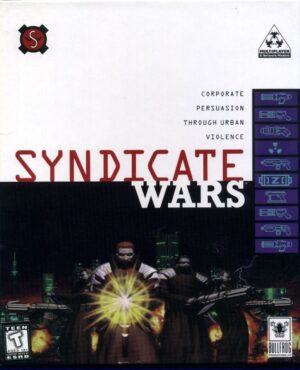Retro Replay Review
Gameplay
Ganbare Goemon: Kuru Nara Koi! Ayashi Geikka no Kuroi Kage offers a refreshing take on the established formula of the series by transitioning into a fully polygonal 3D platformer. The semi-isometric, fixed third-person perspective provides a clear view of Goemon’s surroundings while preserving the tight platforming challenges that fans expect. Players will find themselves leaping across rooftops, navigating narrow ledges, and timing precise jumps to avoid pitfalls and traps, all while making use of each character’s unique movement abilities.
(HEY YOU!! We hope you enjoy! We try not to run ads. So basically, this is a very expensive hobby running this site. Please consider joining us for updates, forums, and more. Network w/ us to make some cash or friends while retro gaming, and you can win some free retro games for posting. Okay, carry on 👍)
Character variety is at the heart of the gameplay loop. Goemon’s nimble acrobatics, Ebisumaru’s heavier but powerful attacks, Sasuke’s gadget-based traversal, and Yae’s balanced skillset ensure that each section feels distinct. In addition to standard platforming, the game integrates a revamped combat system reminiscent of traditional fighting games, complete with combo chains and special moves. This hybrid approach keeps encounters fresh, encouraging players to experiment with different characters and strategies to defeat the Ayashi clan’s curious foot soldiers and monstrous bosses.
Adding another layer of complexity are the impact sequences, where each character pilots their “giant mecha” in over-the-top battles against colossal foes. These sections break the flow in an exciting way, presenting action-packed set pieces that contrast with the precision platforming and narrative-driven exploration. Between stages, a variety of mini-games—ranging from reflex-based challenges to timing puzzles—act as delightful palate cleansers and reward diligent exploration with rare items and upgrades.
Graphics
The transition to a fully polygonal engine marks a significant visual leap for the Ganbare Goemon series on the original PlayStation hardware. Environments are richly detailed, with vibrant textures bringing feudal Edo Japan to life—from bustling market streets and serene gardens to ominous Ayashi strongholds. The semi-isometric viewpoint, while fixed, is skillfully arranged so that players can appreciate the depth of each scene without losing sight of platforming routes.
Character models exhibit the series’ trademark cartoony charm but with added nuance thanks to improved polygon counts. Faces are expressive during cutscenes, conveying Goemon’s trademark bravado, Ebisumaru’s comedic relief, and Yae’s determined resolve. Texture work on clothing, architecture, and natural elements such as cherry blossoms and stone bridges is surprisingly polished, especially considering the era’s hardware limitations. Subtle animations—like flags fluttering in the breeze and lanterns swaying—add to the world’s dynamism.
Performance remains largely stable throughout most levels, with only occasional slowdowns when multiple characters, enemies, and dynamic effects converge on screen. Boss battles in particular can push the engine to its limits, but the slight dips in frame rate do little to hamper the enjoyment of these cinematic encounters. Overall, the graphical presentation strikes a commendable balance between nostalgic stylization and the technical ambitions of early 3D game design.
Story
The narrative of Kuru Nara Koi! Ayashi Geikka no Kuroi Kage follows Goemon and his loyal companions as they once again rise to defend feudal Japan from the insidious Ayashi clan. The game wastes no time establishing stakes: the Ayashi seek to eliminate Goemon as the first step in their plan to seize control of Edo. This clear premise propels players through a series of colorful stages, each culminating in confrontations that weave humor and drama in equal measure.
Dialogues are peppered with the series’ signature wit and quirky cultural references, ensuring that even straightforward fetch quests or platforming detours feel lively. NPC interactions in neutral zones deepen the world-building, offering side lore, optional tasks, and occasional comedic relief. While the overarching plot remains relatively linear, occasional twists—such as betrayals within the Ayashi clan or revelations about Goemon’s past—add enough intrigue to maintain player engagement.
Voice samples and atmospheric soundtracks complement the story beats, with traditional Japanese instruments underscoring moments of tension and comedic stings punctuating lighter exchanges. The pacing strikes a comfortable rhythm: exploration and dialogue segments alternate with action sequences, preventing the narrative from stagnating and keeping the player motivated to see how Goemon’s adventure unfolds.
Overall Experience
Ganbare Goemon: Kuru Nara Koi! Ayashi Geikka no Kuroi Kage succeeds in revitalizing the series’ classic charm within a 3D framework. Its blend of precision platforming, fighting game-style combat, giant mech showdowns, and a healthy sprinkling of mini-games ensures variety from start to finish. Longtime fans will appreciate the familiar cast and humor, while newcomers can easily jump in thanks to intuitive controls and clear level design.
Minor technical hiccups—such as occasional frame rate dips and the limitations of a fixed camera—do little to detract from the core enjoyment. The game’s vibrant art style, engaging soundtrack, and lighthearted narrative create an inviting atmosphere that shines even decades after its original release. Replayability is bolstered by hidden secrets in each stage, unlockable costumes, and the challenge of mastering each character’s skill set.
For anyone seeking a taste of traditional Japanese-themed action-platforming with innovative twists, Ganbare Goemon: Kuru Nara Koi! Ayashi Geikka no Kuroi Kage remains a standout title on the PlayStation. It’s a testament to Konami’s willingness to experiment with beloved franchises, offering an experience that’s as charming and unpredictable as it is challenging and rewarding. Whether you’re in it for the nostalgic appeal or the fresh mechanics, Goemon’s latest adventure is well worth your time.
 Retro Replay Retro Replay gaming reviews, news, emulation, geek stuff and more!
Retro Replay Retro Replay gaming reviews, news, emulation, geek stuff and more!




Reviews
There are no reviews yet.